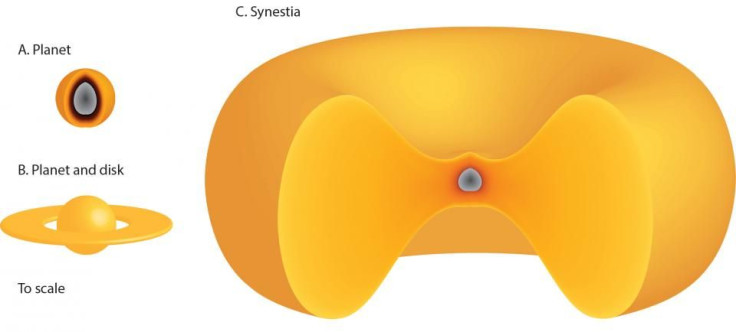Earth Used To Be A Synestia, A Donut-Shaped New Type Of Planetary Object That Scientists Are Proposing

Earth wasn’t always the almost-spherical planet we know it to be. In the early years of its formation, when the solar system was still young and collisions commonplace, it looked something like a donut with its center filled in, a new proposal by planetary scientists says.
That extremely large donut was spinning, like Earth and other planets do today and was made up of rock so hot, it existed almost entirely as vapor, the proposal says. And Earth wasn’t alone in having that seemingly strange shape. According to Simon Lock of Harvard University and Sarah Stewart from the University of California, Davis — the scientists who proposed this theory — Earth was, in its early history, a synestia — a new type of planetary object with the characteristics just mentioned.
Read: A ‘Styrofoam’ Planet With Small Mass, Large Size
A popular theory attributes the formation of planets like Earth, Mars, and Venus in the solar system to collisions and impacts between smaller objects. Even the formation of the moon, about 100 million years after the solar system came into existence, is theorized to have been caused by a Mars-sized object smashing into Earth. Lock and Stewart study how such giant impacts can lead the formation of planets and are particularly interested in studying the impacts between spinning objects.
“We looked at the statistics of giant impacts, and we found that they can form a completely new structure,” Stewart, a professor, said in a statement Monday.
Along with Lock, a graduate student, she “found that over a range of high temperatures and high angular momentum, planet-sized bodies could form a new, much larger structure, an indented disk rather like a red blood cell or a donut with the center filled in. The object is mostly vaporized rock, with no solid or liquid surface.”
They named this kind of an object synestia, a portmanteau created using syn- (together) and Hestia (Greek goddess of architecture and structures).
Angular momentum is a force that all rotating objects have, and for any given object or system, its angular momentum remains constant unless an external factor affects it. The example of an ice skater is often used to explain it, as in the statement by the researchers.
“Think of a skater spinning on ice: If she extends her arms, she slows her rate of spin, and to spin faster she holds her arms close. Her angular momentum is the same. Now consider two ice skaters turning on ice: if they catch hold of each other, the angular momentum of each adds together, so their total angular momentum must be the same,” it said.
But how exactly does a synestia form? When a spinning solid planetary body undergoes a giant impact, its material can become molten or gaseous due to the heat generated by the collision. This causes the material to expand in volume, compared to its earlier solid state, and if it has both size and speed enough, some of that material goes into orbit around the rest, leading to the disk-shaped synestia. For the same amount of mass, a synestia is much larger than a solid planet.
However, a planet would not last very long in its synestia form. Stewart said Earth likely spent only about 100 years as a synestia before it lost enough heat to condense once again into a solid state. Larger planets or hotter objects, such as gas giants and stars, could potentially last much longer as a synestia, she added.
The UC Davis professor also said the moon could have formed when the giant impact, instead of scattering debris that later coalesced into the moon, created a synestia out of which both Earth and the moon later condensed.
A synestia has never been observed directly, but researchers hope they can be found in other solar systems when astronomers start looking for them.
The new planetary object was described in a paper titled “The structure of terrestrial bodies: Impact heating, corotation limits, and synestias,” published online Monday in the Journal of Geophysical Research.
© Copyright IBTimes 2024. All rights reserved.











